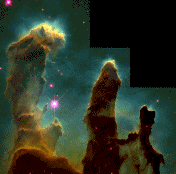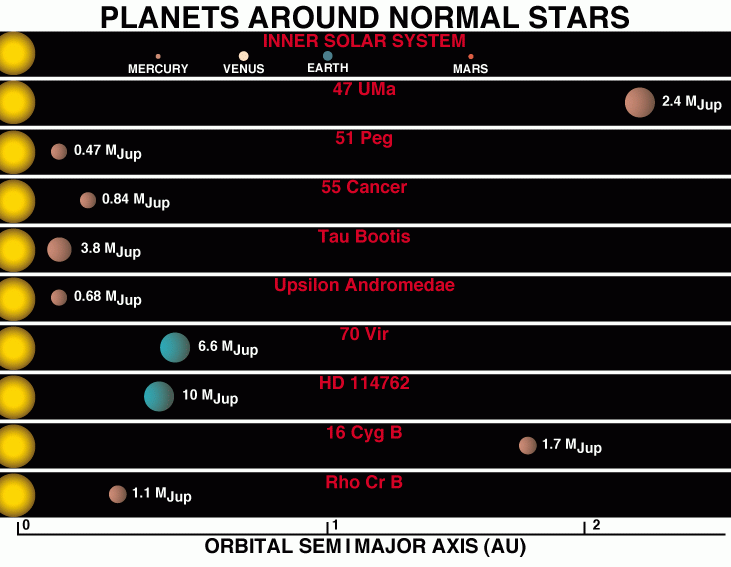Lecture 24 - Origins and Endings (12/10/98)
 The Sun --- |
The Sun --- |

Reading:
Chapter 16-1, 16-3, 16-5, 15-3 (ZG4)
Gaseous pillars in the Eagle Nebula M16 seen by HST.
(HST/NASA)
 |
Key Question: |
How did the solar system form?
|
|---|
 |
Key Principle: |
Gravitational Collapse
|
|---|
 |
Key Problem: |
Why does the proton-proton reaction
take so long, while the triple-alpha reaction is fast?
|
|---|
 |
Key Quote: |
|
|---|
Investigations:
- Solar Thermonuclear Reactions
- How does the weak nuclear force allow a proton to change
into a neutron (or visa versa)?
- What is a positron?
- What is a neutrino?
- What is the proton-proton chain?
- In what form is the energy released in the proton-proton reaction?
- What are the timescales of the three steps of the p-p reaction?
Which is the limiting stage?
- How many neutrinos are released per helium nucleus created?
- How is mass converted to energy in nuclear reactions?
- Which step of the proton-proton chain liberates the most energy?
- What is the difference in mass between 4 protons and 1 Helium nucleus?
How much energy is this equivalent to?
- What fraction of the mass of hydrogen is converted into energy in
one reaction chain? Where does this energy go?
- How many kilograms of hydrogen must be fused each second to supply
the luminosity of the Sun?
- How long can this last if 13% of the mass of the Sun is available
for fusion?
- How many conversions per second are needed?
- How do you get protons close enough together to interact and
form nuclei?
- What is the curve of binding energy per nucleon versus atomic
mass?
- Which elements can release energy through nuclear fusion?
- Which through nuclear fission?
- Which element is energetically stable against fusion or fission?
- Why might we be rather skeptical about claims of cold fusion
based on what we know about nuclear and electromagnetic forces?
- The Proton-Proton Chain
- Approximately what is the thermal energy required to overcome
the Coulomb barrier? What temperature does this correspond to?
- What is the main proton-proton chain (PP I)?
- What step takes the longest to occur? Why? What is the implication
of this?
- What is the significance of neutrinos in the P-P reaction? How many
are generated each second?
- What are the PP II and PP III chains?
- Where do high energy solar neutrinos come from?
- What is the solar neutrino problem?
- How do you detect solar neutrinos?
- Other Fusion Chains
- At what temperature does the P-P reaction "turn on"?
- What is the CNO cycle? Why is it equivalent to P-P?
- At what temperature does CNO turn on? When does it dominate PP?
- What are the temperature dependences of PP and CNO?
- What is the triple-alpha process or helium burning?
- What are the temperature thresholds and reactions in carbon, oxygen,
and silicon burning?
- How do you get heavier nuclei to fuse in a star?
- What happens when you try to fuse iron-peak elements (Fe, Co, Ni)?
- Degeneracy
- What happens to the core of a star when it has exhausted a given
fuel for a particular fusion reaction?
- Is there any pressure other than gas pressure available to stop
the collapse of a stellar core?
- What is the smallest "orbital radius" r into which you can squeeze an
electron (or proton) of momentum p?
- What is the Heisenberg Uncertainty principle for position and
momentum?
- What is the Pauli exclusion principle and what is its
implication for electrons?
- What is the degeneracy pressure of an electron gas?
- Because the degeneracy pressure is independent of temperature,
what happens in the contraction of a degenerate helium core after
hydrogen burning ends?
- What is the Chandrasekhar limit?
- The H-R Diagram: Stellar Evolution
- How does the luminosity of a star evolve while it is on the
main sequence and why?
- What happens to the core after hydrogen exhaustion?
- What happens to the stellar envelope when hydrogen shell burning
commences?
- What is a subgiant?
- What is the red giant branch (RGB)?
- What is the helium flash?
- How is degeneracy lifted after the helium flash?
- What happens after core helium burning ends?
- What is the horizontal branch (HB)?
- What is the asymptotic giant branch (AGB)?
- What is a planetary nebula?
- What is a white dwarf and what is its ultimate fate?
- How do heavy elements form in a massive star?
- What happens when a iron/nickel core forms?
- What is a neutron star?
- How many neutrinos does the formation of a neutron star produce?
- What is a supernova?
- What are supernova remnants?
- How many neutrinos were detected from supernova 1987A?
- How does the main sequence lifetime of a star scale with mass?
- Why are the post-main-sequence phases shorter?
- How can the main sequence turn-off be used to determine the age
of a star cluster?
- The Solar Nebula
- What is a molecular cloud?
- What molecules have been detected in molecular clouds and how?
- How did the proto-solar nebula collapse to form the solar system?
- Why did a disk form? What determined its rotational axis?
- How did the central pressure and temperature of the proto-sun evolve?
- How are the pressure, density and temperature of a gas related?
- What are the central pressures and temperatures of the Earth, Jupiter
and the Sun?
- What important process turns on at a temperature of 4 million K in
a stellar object?
- At what mass do we expect a giant planet to become a star?
- Why are the inner planets different than the outer planets?
- How are planetesimals built up from dust grains in the cooling nebula?
- How do planetesimals "seed" the growth of planets?
- Are there any planetesimals around today?
- What determines the spacing and size of planets?
- Where are the "domains" of rock, gas, and ice in the solar
system?
- Where did the atmospheres and hydrospheres of the inner planets come
from?
- Are the satellite systems of Jupiter and Saturn microcosms of the
solar system itself?
- How are the anomalous compositions of the Moon and Mercury accounted
for?
- How are the extreme obliquities of the rotations of Venus and Uranus
accounted for?
Solar Neutrinos:
Neutrino Astrophysics has a long tradition at Penn. There is a good
discussion of the
implications of the results of solar neutrino experiments set up by
the group.
Some links to neutrino experiment sites:
Extrasolar Planets:
This is a particularly exciting time in solar system astrophysics
as a number of planets orbiting nearby stars has been found in the last
couple of years. These were dectected by noting the doppler shifts of
the primary star due to motion around the barycenter induced by the planets.
Due to senistivity constraints, only large planets have been detectable
in this manner.

Courtesy P.Butler,G.Marcy (SFSU)
See the following sites:
 Prev Lecture ---
Prev Lecture ---
 Astr11 Index ---
Astr11 Index ---
 Astr11 Home
Astr11 Home
smyers@nrao.edu
Steven T. Myers
 The Sun --- |
The Sun --- |
 The Sun --- |
The Sun --- |






 Prev Lecture ---
Prev Lecture ---
 Astr11 Index ---
Astr11 Index ---
 Astr11 Home
Astr11 Home